AS 332 Final Exam
1/92
There's no tags or description
Looks like no tags are added yet.
Name | Mastery | Learn | Test | Matching | Spaced |
|---|
No study sessions yet.
93 Terms
(5-6) Define complete dominance, partial dominance, no dominance, and overdominance. You may use examples to help explain your definition, but an example is not sufficient by itself as an answer.
Complete dominance - When an allele completely masks the expression of a second allele at a locus
Partial dominance - When an allele partially masks the expresion of a second allele at a locus
No dominance - When neither allele masks the expression of another allele at a locus
Overdominance - Heterozygote is greater or lesser than the values of both homozygotes
(9) Compare and contrast the terms dominance and epistasis
Dominance - 1 locus
Epistasis - > 1 locus
Both - interaction between alleles
(1-4) Define chromosome, allele, locus, and gene
Chromosome - Threadlike structure of DNA and protein that contains genetic information
Allele - Variant in the DNA
Locus - A location in the DNA
Gene - DNA sequencce that encodes a biologically important molecule
(7) Define Mendel’s two laws
Law of Segregation - At each locus in a parent, each of their offspring has an equal chance of inheriting either allele
Law of Independent Assortment - At 2 loci, the allele transmitted to offspring at one locus tells us nothing about which alleles are transmitted at other loci
(10) Explain the differences between sex-linked, sex-influenced, and sex-limited inheritance
Sex-linked - A trait determined by a locus on a sex chromosome
Sex-influence - Phenotype is determined by an interaction between genotype and sex
Sex-limited - Trait is expressed in only one sex
(41-42) List the four bases (not just the abbreviations) that comprise DNA. Identify which bases are purines and which bases are pyrimidines
Purines - Adenine, Guanine (Agriculture is pure)
Pyrimidine - Cytosine, Thymine
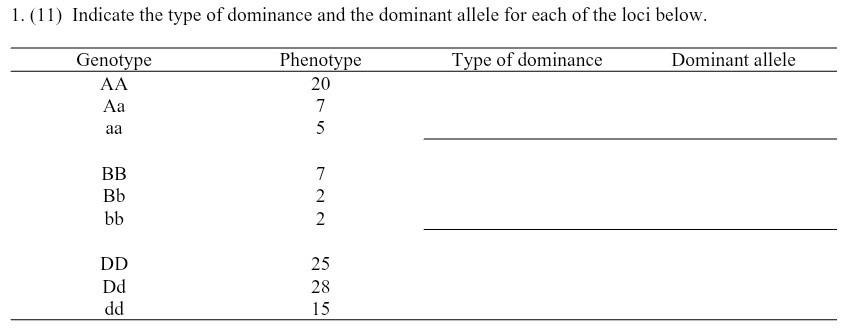
(11) Indicate the type of dominance and the dominant allele for each of the loci below
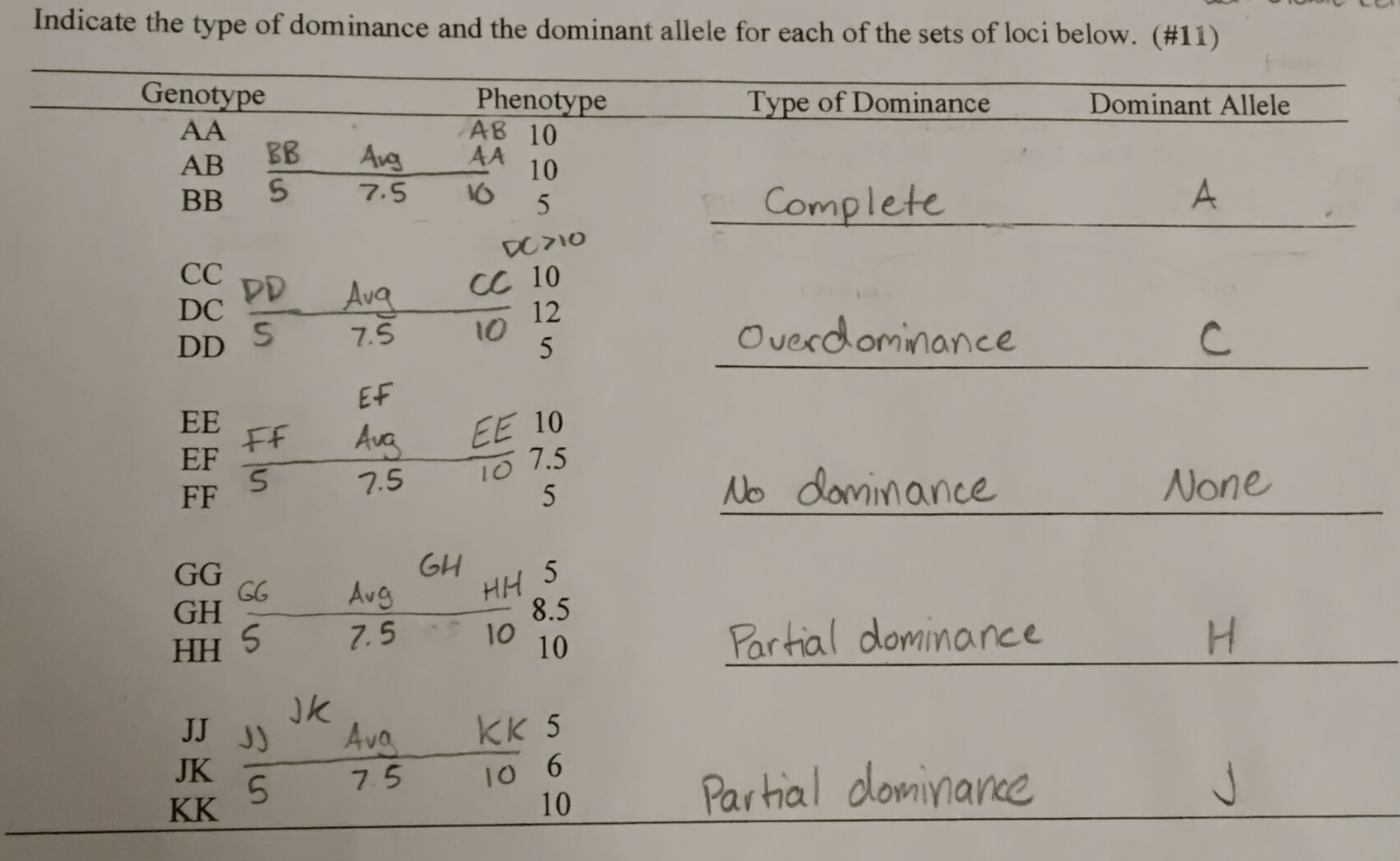
(45) The double strands of a DNA bhelix bind in a [parallel, antiparallel] direction
Antiparallel
(56) Explain how DNA is replicated. Include in your answer the roles played by the helicase, single-stranded binding proteins, DNA polymerase III, DNA polyerase I, and DNA ligase. You may use (a) drawing(s) to help explain DNA replication
The DNA helix is unwound
The RNA primers are added to the DNA
A new strand of DNA is synthesized
The RNA primers are replaced with DNA
The Okazaki fragments are ligated together
(1) Explain how DNA is transcribed into RNA. INclude in your answer the roles played by the promoter, transcription factors, RNA polymerase II, and the hairpin loop. You may use (a) drawing(s) to help explain transcription
The RNA polymerase 2 binds to the promoter
The DNA helix is unwound and RNA is synthesized
Transcription is stopped by a hairpin loop
(13) Explain how mRNA is translated into protein. Include in your answer the roles played by the ribosome, aminoacyl site, transfer RNA, peptidyl site, exit site, and messenger RNA. You may use (a) drawing(s) to help explain translation
The small ribosomal subunit binds to the mRNA
The small ribosomal subunit identifies that start codon and the large ribosomal subunit binds to the small ribosomal subunit to complete the ribosome
A tRNA with an anticodon complementary tot he mRNA start codon in the aminoacyl region enters the aminoacyl region
The ribosome shifts three nucleotides such that the codon/tRNa in the aminoacyl region is now in the peptidyl region and a new codon enters the aminoacyl region. A new tRNA enters the aminoacyl region
The amino acids on the tRNA in the peptidyl region are transferred to the amino acid on the tRNA in the aminoacyl region
Repeat steps 4-5 until a stop codon enters the aminoacyl region
(6) What is the difference between an exon and an intron
Onlys exons are translated into protein
(3) What are the three steps during RNA processing before translation
Adding a 7mG to the 5’ end
Adding a poly A to 3’ end
Remove introns from mRNA
(17) Translate the following mRNA using the genetic code table
5’ G C A U C A U G C A U U A C C C A A A U U A U U U A G A U U A A C A A A A 3’
Met, His, tyr, Pro, Asn, Tyr, Leu, Asp
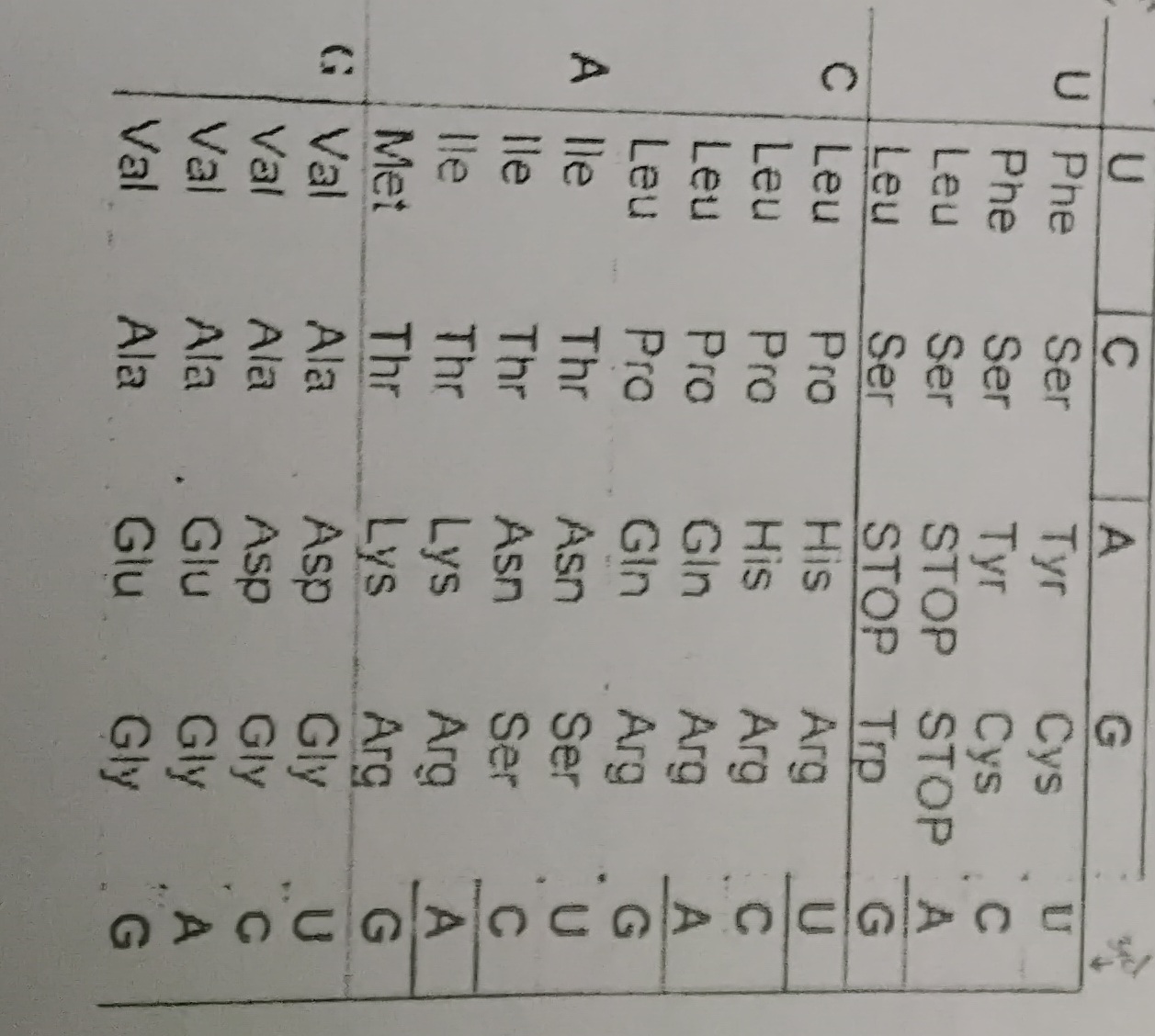
(22) What is the function of a transcription factor
Increase gene expression
Why are transcription factors necessary in cells
Increase gene expression by binding enhancer and promoter DNA sequences and RNA polymerase 2
(44) What is the difference between a gene edited animal and a cloned animal
Cloning - Replicating entire genome
GE - Changing DNA sequence
(46-47) What are two argments for the use of transgenic or gene edited animals? What are two aguments against their use that we discussed in class
Improved animal welfare, improved disease resistance, improved productivity
Consumer acceptance, Unintended consequences of the gene edit
(1) List one trait that meets each of the criteria listed below
A. Simply inherited and qualitative
B. Polygenic and qualitative
C. Polygenic and quantitative
A. Coat color
B. Litter size
C. Yield
(7) Why is selection for a simply inherited trait often easier than selection for a polygenic trait
Only 1 or a few loci affect the trait
Environment has minimal effect on the trait
(5) What are three ways of eliminating the appearance of genetic abnormalities in a herd
DNA test and cull carriers
DNA test sires, only use non-carriers
Crossbreeding
DNA test and mate carriers to non-carriers
(12) What is measured by a standard deviation
About the average deviation of an observation from the mean
(23) Classify each of the correlation coeficients below as 1) positive or negative and 2) strong or weak
A. +0.89
B. +0.02
C. -0.91
A. Positive, strong
B. Positive, weak
C. Negative, Strong
Draw a graph of a regression we have discussed in class AND fill in the blanks below. “For my regression graph, _____ is being used to predict _____.”
(15) What percent of a population would fall within one standard deviation of a mean
68%
(26) In horses, the B allel results in brown coat color, and the b allele results in white coat color. The two allels exhibit no dominance and the heterozygous (Bb) individuals have palomino (blonde) coat color. A herd of horses is in Hardy-Weinberg Equilibrium at this locus. The frequency of the B allele is 0.7 and the frequency of the b allele is 0.3
A. What are the expected numbers of foals of each color among 100 foals born in the current season?
Brown ____
Palomino ____
White _____
B. If all the white foals are sold, what are the frequencies of the brown (B) and white (b) alleles in the remaining foals?
Frequency of B allele ____
Frequency of b allele ____

(27) Explain why it is possible to completely eliminate a dominante allele from a population through selection but almost impossible to completely eliminate a recessive allele through selection. Assume a DNA test for the allele does not exist
Heterozygotes look identical to homozygous dominant animals
As the frequency of the recessive allele decreases, most of these alleles are found in heterozygotes
(21) What is Hardy weinburg Equilibrium
When no forces are acting, then allele and genotype frequencies remain constant across generations and genotype frequencies go to HW proportions
(22-23) List the five forces that can change genotype frequencies in a population. Of these five forces, which force cannot change allele frequencies
Random drift, migration, selectoin, non-random mating, mutations
Non-random mating
(25) Provide an example of each of the five forces above at work in animal breeding
Mutation - A polled calf is born in a herd where all bulls and cows are horned
Migration - I purchase polled cows from a local sale
Selection - I do not retain animals with horns each breeding season
Random Drift - In a closed herd, animals that are polled and have horns are present in each calving season. the herd manager retains calves irrespective of whether horns are present
Non-random mating -
(39) A dam with an EPD = +40 is mated to a sire who EPD is +80. Assuming this information is all we have, answer the following questions
A. What is the EBV of an individual offspring of this mating
B. What is the average EBCV of all offspring of this mating at this point in time
C. Do all offspring have the same EBV at this time? Explain
D. Do all offspring have the same true breeding value at this time? Explain
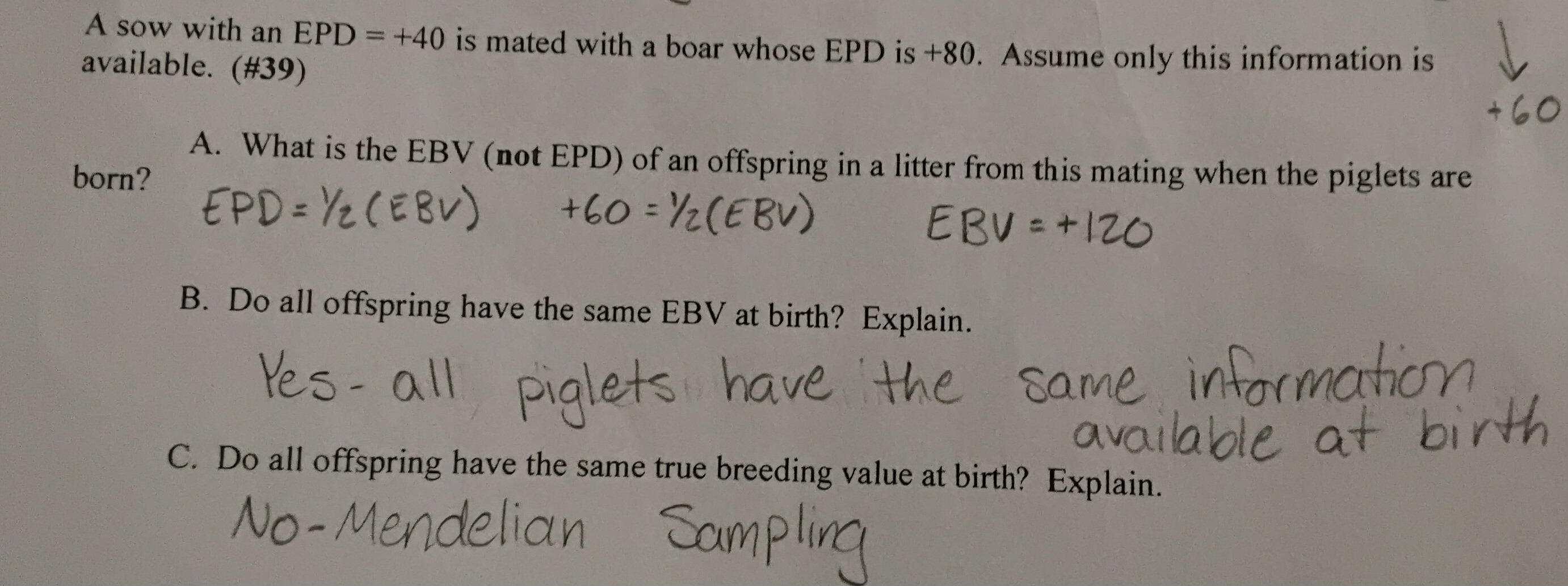
(40) How is it possible for the true beeding value of an offspring to be greater than the average of the true breeding value of its parents
Mendelian sampling
(34) The basic genetic model for quantitative traits is P = μ + G + E. Expand this model by replacing G with its components and E with its components for a repeated trait (do not use abbreviations). Provide a definition of each term in the expanded mode
P = μ + BV + GCV + Ep + Et
BV = Genetic value of the nimal as a parent
GCV = Sum of dominance and epistatic effects at all loci affecting a phenotype
Ep = Environmental effects that permanently affects performance
Et = Environmental effects that temporarily affects performance
(38) For a current litter size record, a sow has the following values for the various components of the genetic model for repeated traits
Contemporary group average = 9 piglets
Breeding value (BV) = +2 piglets
Gene Combination Value (GCV) = -3 piglets
Permanent enviornmental effect (Ep) = -1 piglet
Temporary environmental effect (Et) = +4 piglets
What are her values for the following
A. Litter size (P)
B. Genotypc value (G)
C. Producing ability (PA)
D. Progeny difference (PD)
E. Environemental effect (E)
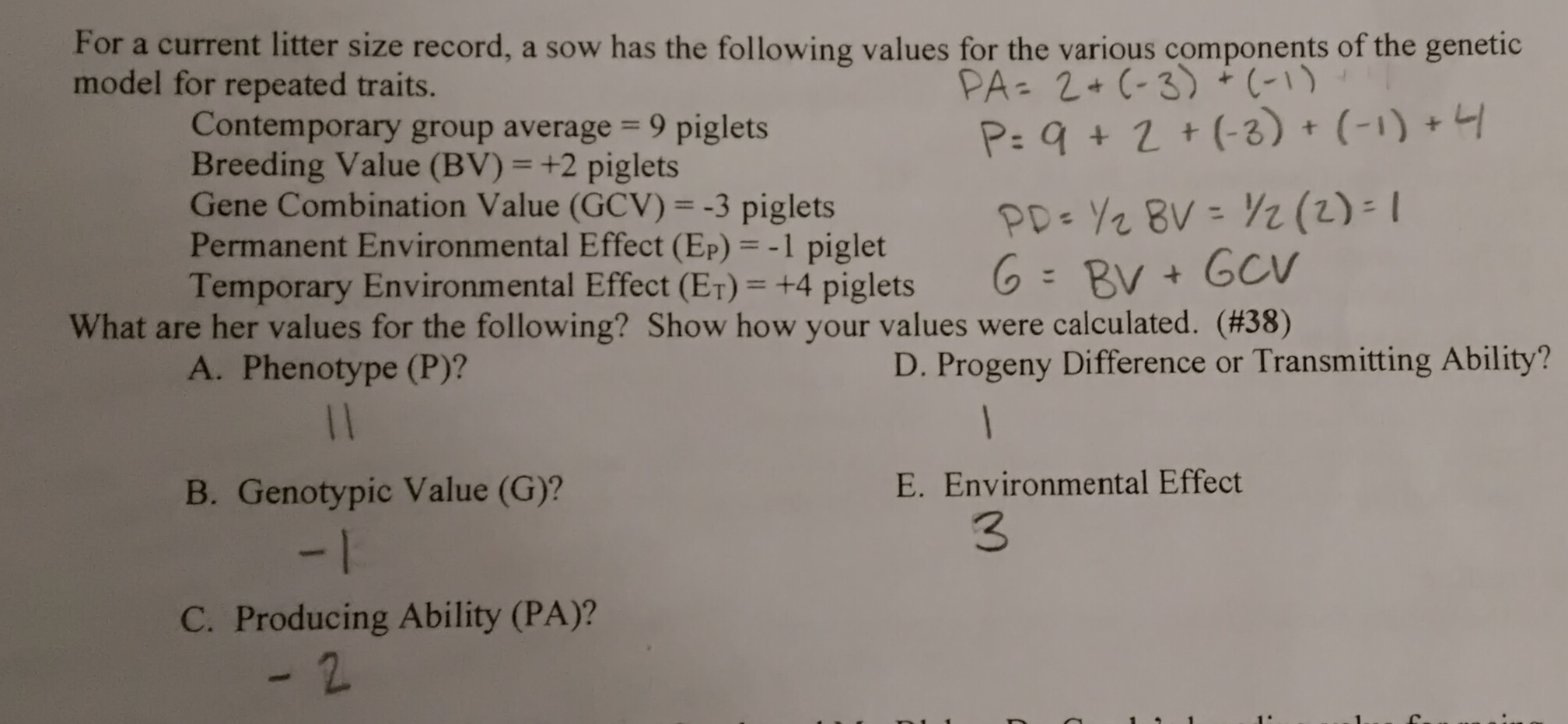
(36) Define the term repeated trait. Provide an example of a repeated trait
A trait that can be measured multiple times in the same animal
Milk yield, racing speed
(37) What is the mathematical relationship between an animal’s breeding value and its progeny difference
PD = ½ (BV)
(13) Define heritability (one definition okay)
Strength of the relationship between phenotype and breeding value for a trait
(14) Why is heritability important
Allows you to determine which traits will be improved faser by genetic selection
(6) List three ways we can increase heritability. Why would you want to increase heritability
Measure traits as accurately as possible, treat animals as uniformly as possible, increase number of records for a repeated trait
Increase accuracy of selection and culling decisions
(11) What is a contemporary group
Group of biologically similar animals raised in the same environment
(30) List and define each of the four factors affecting rate of genetic change
Selection accuracy - Correlation between true and estimated BVs, measure of selection risk
Selection intensity - Standardized difference between mean of selected individuals and overall mean, how picky or choosy you are when selecting animals for a trait
Genetic variation - Standard deviation of BVs
Generation interval - Average age of parents in your herd
Why do we calculate breeding values
To increase selection accuracy
(48) What does it mean when we say that EBV is an unbiased estimate of true breeding value
As we collect more data, the EBV is equallly likely to increase or decrease
(53) A commercial cow-calf producer wishes to calculate within-herd weaning weight EPDs for two of his or her herd bulls. The senior herd sire “Sure Thing” has sired four calf crops, and his 80 progeny average 10 pounds heavier than their contemporary group mates. He also purchased a yearling bull “Long Shot” with no progeny, but who (himself) weighed 40 pounds heavier than his contemporary group average. Assume heritability of weaning weight is 0.30
A. Calculate weaning weight EPD and accuracy for “Sure Thing”
B. Calculate weaning weight EPD and accuracy for “Long Shot”
C. Which sire would expect to sire the heaviest calves in the future? Why?
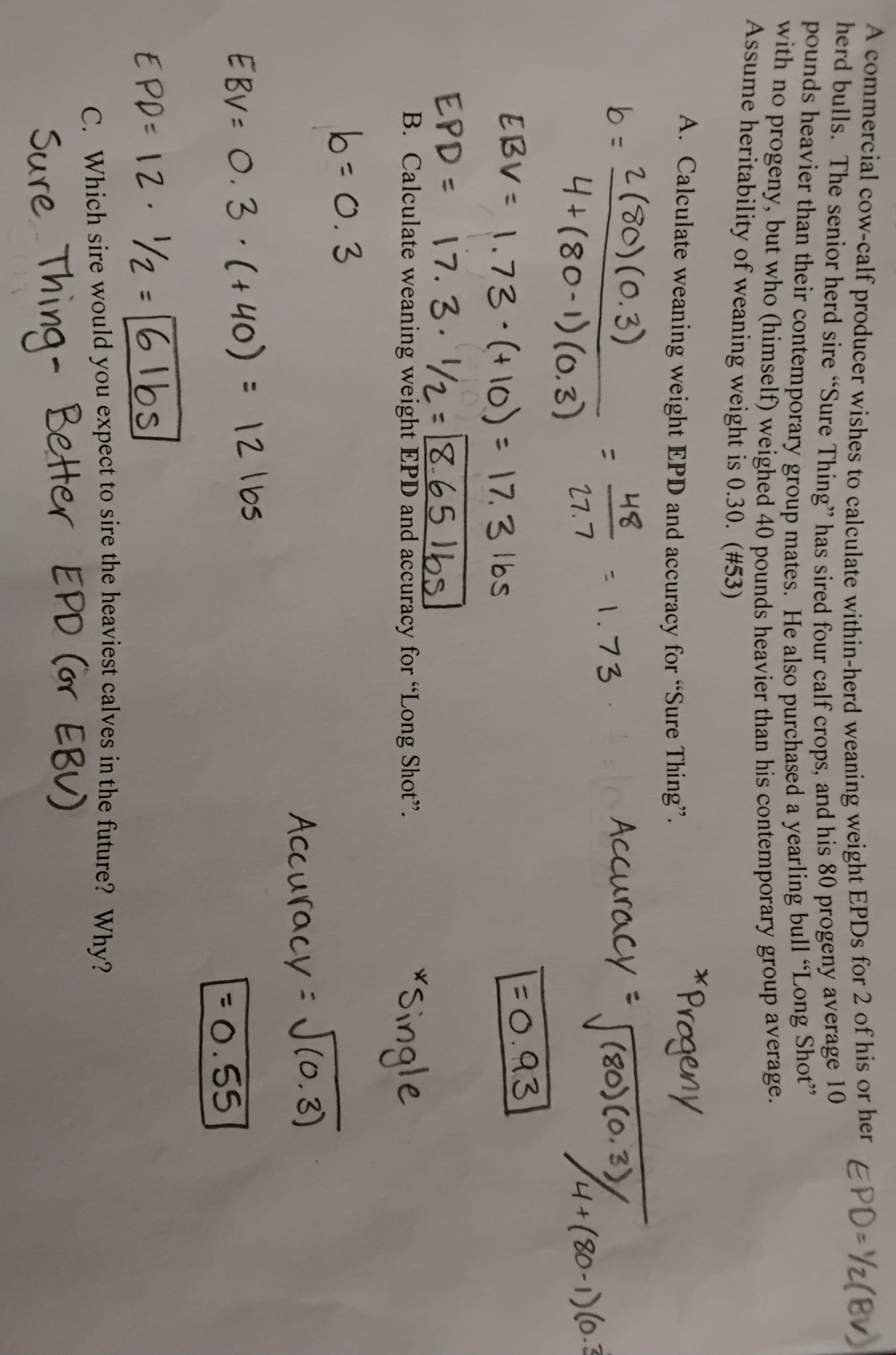
(50) How should EBV accuracy be used when selecting animals
As a measure of selection risk
(54) The EPDs for yearling weight for two bulls are 115 lbs. for Trendsetter and 75 lbs. for Desperado
A. By itself, what does the fact that Trendsetter has an EPD = 115 lbs. mean
B. How much heavier should Trendsetter’s progeny be, on average, relative to Desperado’s progeny
A. Nothing
B. 40 lbs
(56) (T/F) An EPD = 0 is the mean EPD for the breed
False
(48) (T/F) An EPD = 0 is the genetic base for the breed
T

(60) Fintry of Graham 52170, an Angs bull, has a calving ease direct EPD = +4% and the accuracy of this EPD is 0.50. Terefore, we are 68% confident that Graham’s true calving ease direct progeny difference is between what two values?
-1.1% and 9.1%
(61) A bull’s 68% confidence range for weaning weight EPD is +30 lbs. and +50 lbs. What does this mean
We are 68% confident that this bull’s true progeny difference for WW is between 30 and 50 lbs
(9) What is the difference between a negative genetic correlation and an unfavorable genetic correlation
Negative - BVs for 2 traits expected to move in opposite directions
Unfavorable - Correlation you don’t want
Below is a list of breeding objectives used by two cow-calf producers. Both producers reatin ownership of their calves to the packing plant; thus, all traits listed are economically relevant for both producers
Doc - Marbling, Yearling Weight
Tuxedo - Marbling, Yearling Weight, Fat Thickness, Ribeye Area, Carcass Weight
Compare and contrast these breeding objectives
Doc has two traits, which could be negative because they may be ignoring certain traits that could improve profitability
Tuxedo has five traits, which can also be negative because selection intensity on a specific trait is unattainable
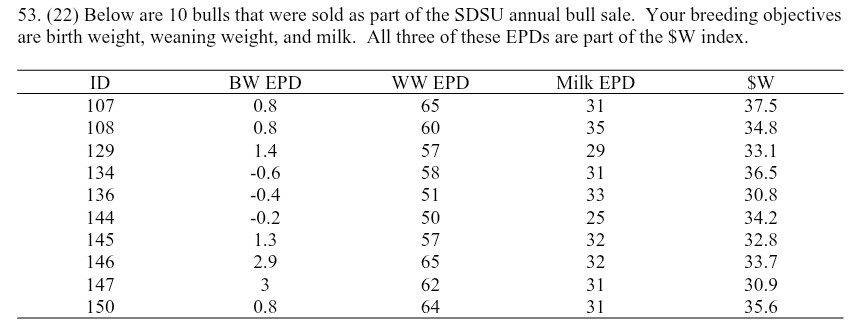
(22) Beloware 10 bulls that were sold as part of the SDSU annual bull sale. Your breeding objectives are birth weight, weaning weight, and milk. All three of these EPDs are part of the $W index
A. Select three bulls by tandem selection, starting with weaning weight EPD. Heavier weaning weight EPDs are more desirable
B. Select three bulls by independent culling levels with the following thresholds
BW EPD < or = 1.0 lbs
WW EPD > or = 59 lbs
Milk EPD < or = 33 lbs
C. Select three bulls using the $W index
A. 107, 150, 146
B. 107, 108, 150
C. 107, 134, 150
(14) Which multiple trait selection strategy is expected to change genetic merit the fastest
Economic selection index
(28) What is the difference between random mating and random selection
Mating - Randomly pairing selected sires and dams
Selection - Ignoring a trait when making selection decisions
(37) How can we reduce mean inbreeding frquency in a herd (two examples required)
Bring in unrelated genetics (outbreeding)
Crossbreed
Pair sires and dams that are least related
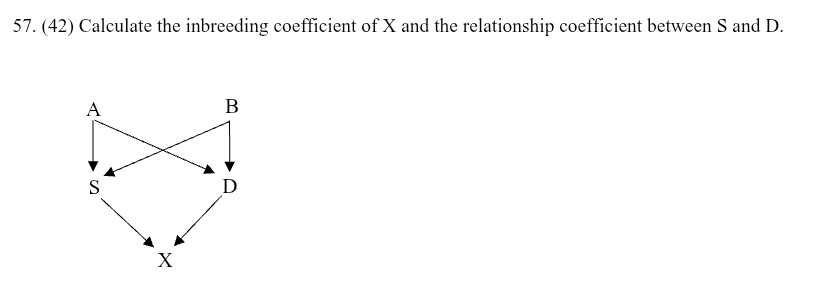
(42) Calculate the inbreeding coefficient of X and the relationship coefficient between S and D

(34) Define inbreeding depression
Decreased performance resulting from increased inbreeding levels
(33) Inbreeding increases [homozygousity, heterozygousity] of alleles at loci
Homozygousity
(40) ________ occurs when two alleles at a locus are identical to each other but not derived from the same ancestor
Identity by state
(61) In a flock of chickens, eggs per hen per year were 324 for Leghorn, 250 for Cornish, and 306 for Leghorn x Cornish crosses
A. What is the amount of hybrid vigor
B. What is the % hybrid vigor
C. Will the crossbred offspring always perform better than both purebred parents for a single trait? Why or why not
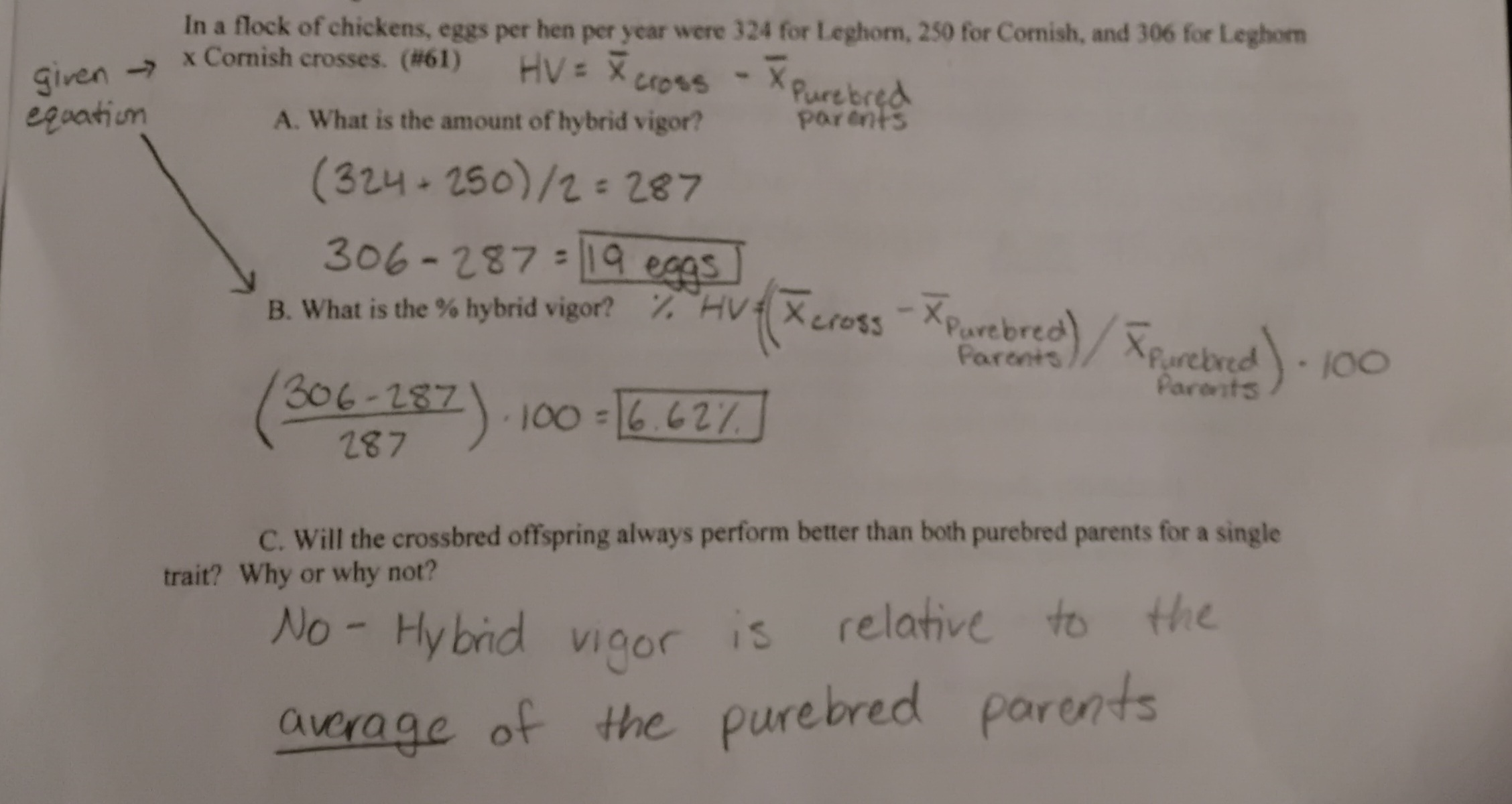
(62) Heterosis increases [homozygousity, heterozygousity] of alleles at loci
Heterozygousity
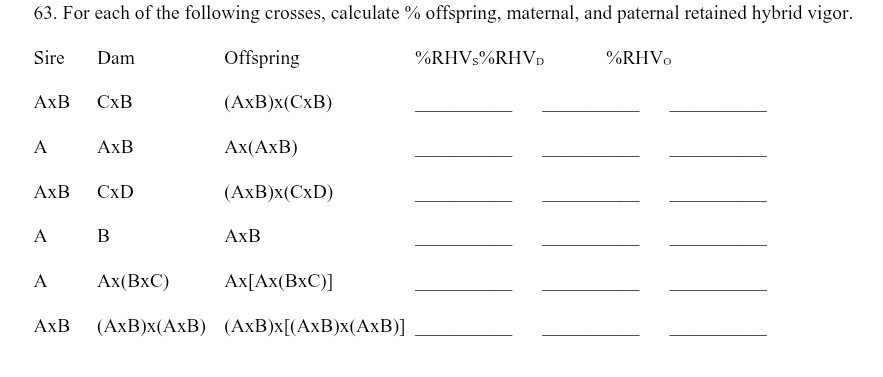
(63) For each of the following crosses, calculate % offspring, maternal, and paternal retained hybrid vigor
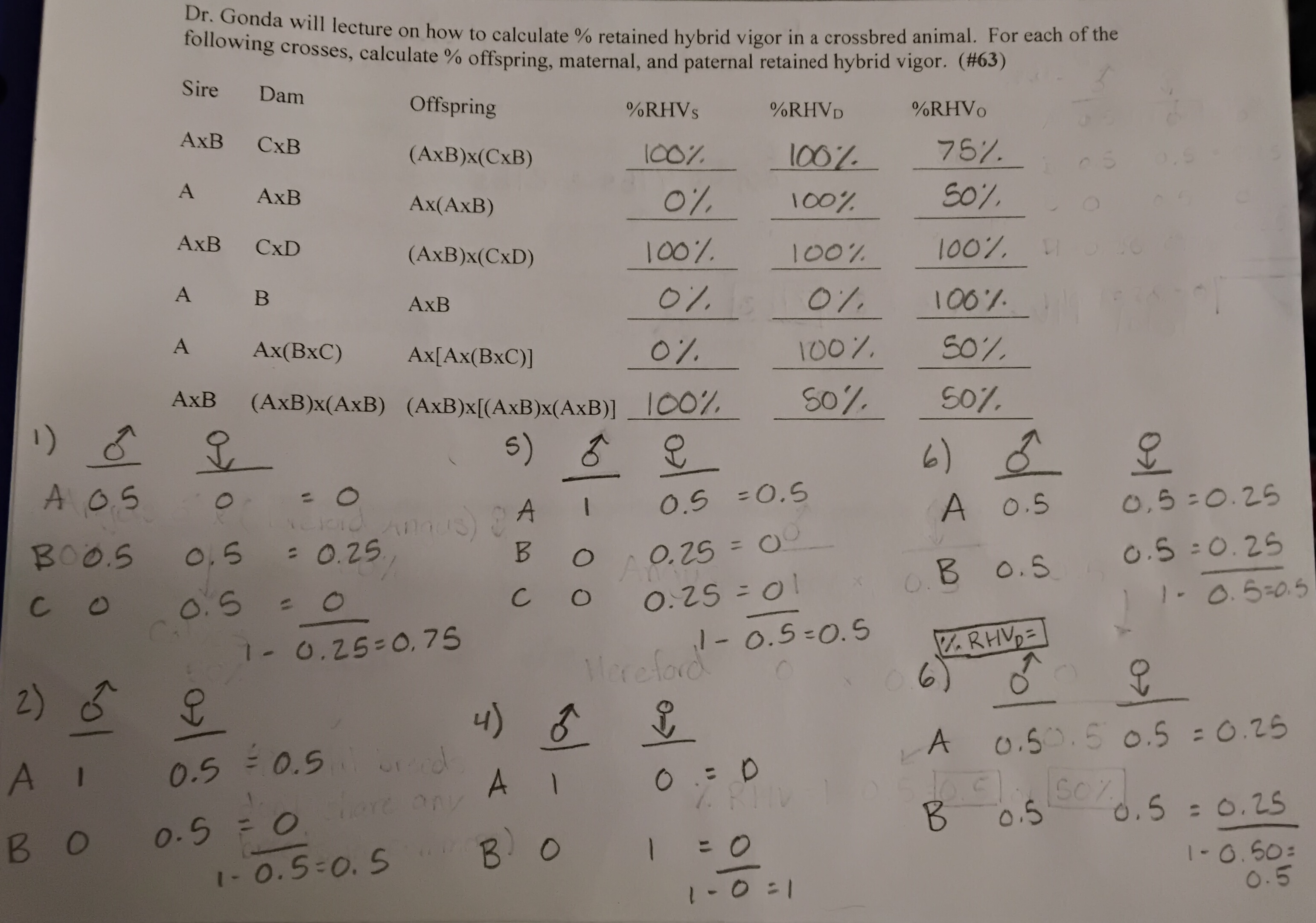
(64) A research station has been comparing purebred and F1 crossesa mong chickens of the Leghorn (L) and Rhode Island Red (R) breeds for number of eggs produced per hen per year. The results are as follows
Purebreds: L = 330, R = 250
F1 crosses LR = RL = 325
A. What is the estimate of % offspring hybriid vigor for number of eggs produced per hen per year
B. If eggs per hen is the only trait considered, which purebred or cross will you use? Explain your answer
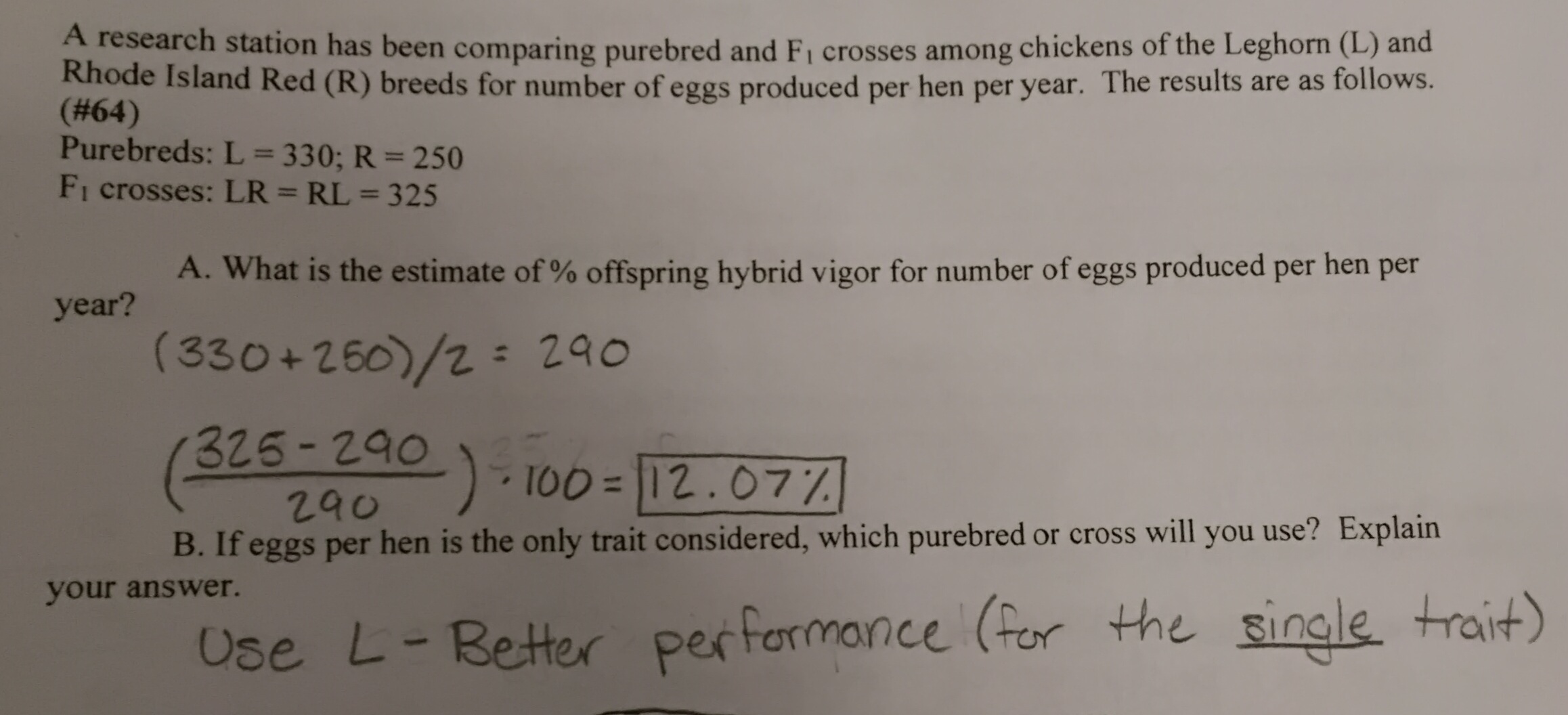
(65) Inbreeding depression and hybrid vigor are due to opposite bu similar genetic causes. Explain
Both affect the GCV but inbreeding depression decreases GCV and heterosis increases GCV
(65) Different traits express different amounts of inbreeding depression and hyybrid vigor. For each of the following six traits, indicate the two traits affected the most (M), the two traits affected an intermediate amount (I), and the two traits affected the least (L) by either inbreeding depression or hybrid vigor
A. Hatchability of eggs in chickens
B. Average daily gain in pigs
C. Milk production in dairy cows
D. Marbling in beef cattle
E. Survival of lambs to weaning
F. Loin eye area in pigs
A. M
B. I
C. I
D. L
E. M
F. L
(67) It is often more important to have maternal hybrid vigor than offspring hybrid vigor. Why
Heterosis affects fertility and survivability traits the most and both of these traits are vital to capture in dams
(68) in a flock of sheep, weaning weights for Hampshire, Dorest, and F1 lambs were as follows
Hampsire purebreds = 60 lbs
Dorset purebreds = 40 lbs
Dorset x Hampshire F1 cross = 54 lbs
A. What is the amount of F1 offspring hybrid vigor for weaning weight
B. If F1 maternal hybrid vigor for weaning weight is 5 lbs, what is the total amount (lbs.) of hybrid vigor for a lamb from a Hampshire ram and a F1 Dorset x Hampshire ewe
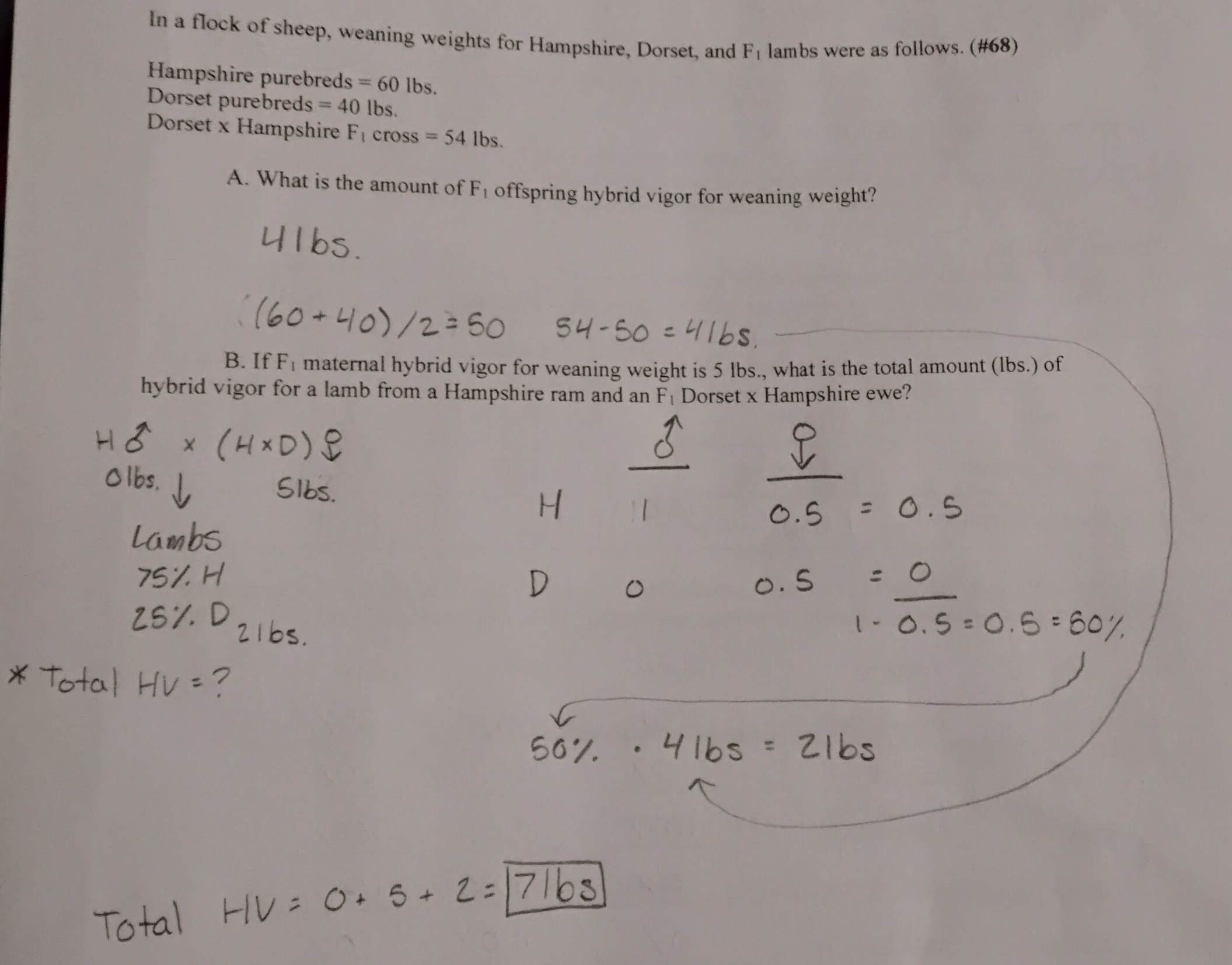
(69) Define breed complmentarity
Matching breeds complementary strengths and weaknesses in a crossbreeding system
(70) Define heterosis or hybrid vigor
Increased performance of crossbred offspring relative to the average of the purebred parents

(71) Complete the following table by adding the words “high",” “moderate,” or “low” into each empty cell

(72) Between a well-designed terminal and rotational crossbreeding system, which system makes the best use of breed complementarity? Why
Terminal
Rotation = breed complementarity is antagonistic to offspring uniformity
(73) As the number of breeds in a rotational crossbreeding system increases, the amount of retained F1 hybrid vigor [increases, decreases, remains the same]
Increases
(74) A _____ is a breed made up of two or more component breeds and designed to benefit from hybrid vigor without crossing with other breeds
Composite
(75) What are three considerations to take into account when designing and evluating crossbreeding systems
Breeds
Breed complementarity
Simplicity
(76) Provide one example of a composite breed
Simm-angus
Polypay sheep
Brangus
(77) (T/F) Crossbred offspring are more variable in performance and body size than purebred offspring
False
(78) list one advantage and one disadvantage of a rotation in time over a rotation in space
Time - Simpler
Space - More RHV
(79) List one advantage and one disadvantage of each of the following crossbreeding systems
A. Two-breed rotational system
B. Terminal system
C. Rota-terminal system
D. Composite
A. Adv - Raise replacement females Disadv - Offspring uniformity is antagonistic to breed complementarity
B. Adv - Simplicity Disadv - Ability to raise replacement females
C. Adv - Raise replacement females Disadv - Complex
D. Adv - Raise replacement females Disadv - EBVs not available
(80) Draw or describe each of the following crossbreeding systems
Two-breed rotational system (in space or in time)
Two breed rota-terminal system (i.e., two breeds in rotation and one sire breed in terminal part of system)
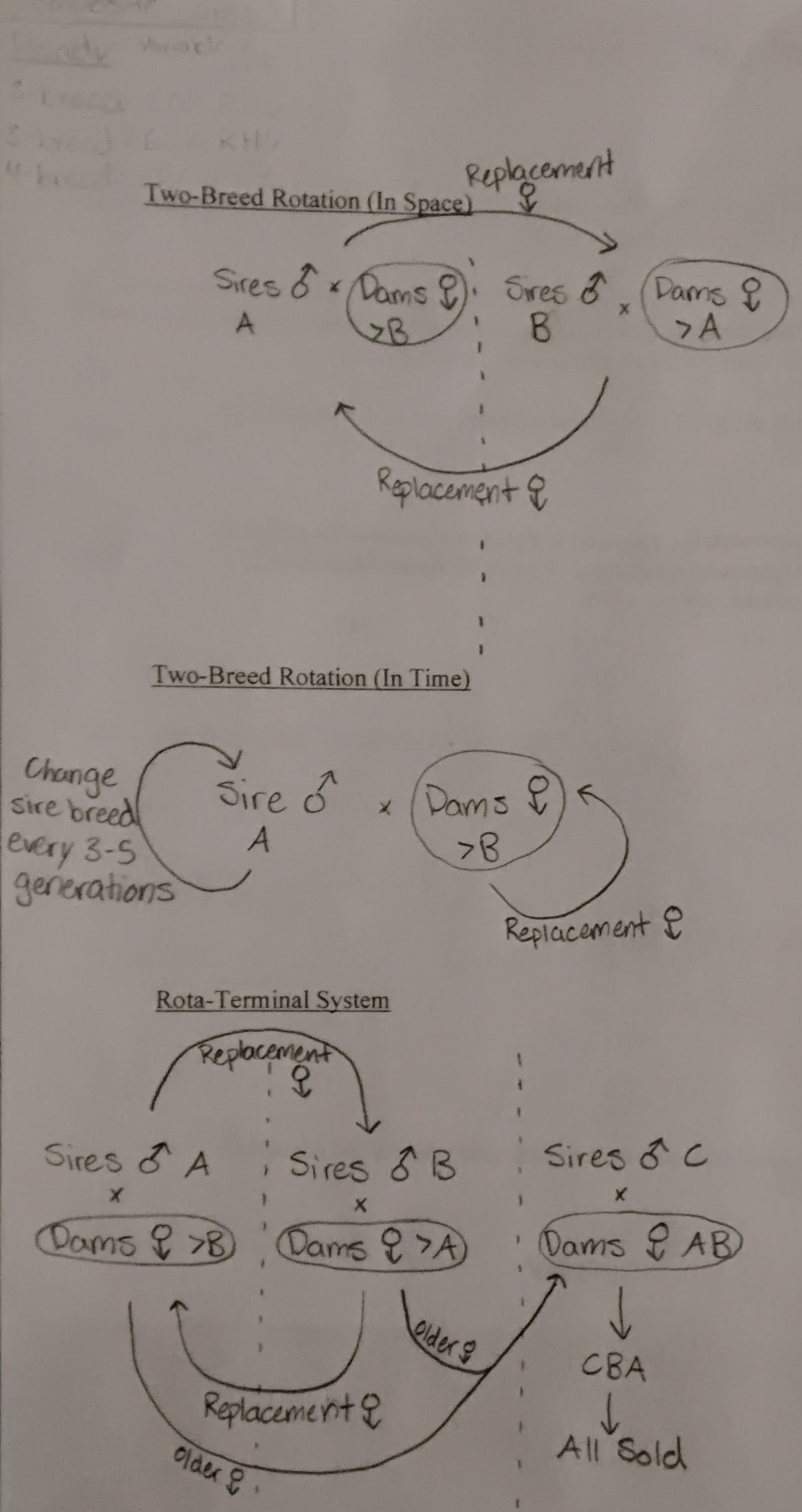
(80) Draw or describe each of the following crossbreeding systems
Terminal system (purebred or crossbred dams)
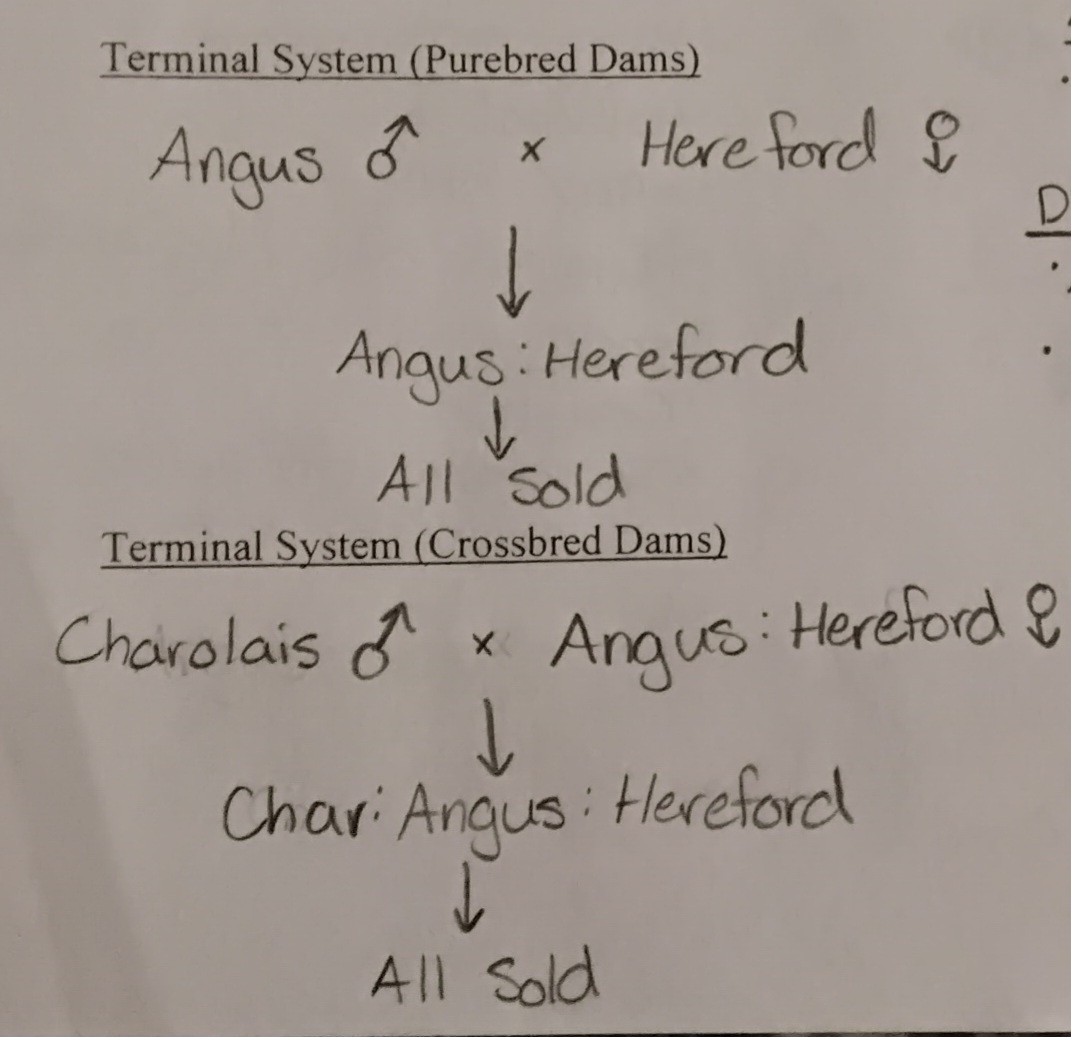
For each of the following statements, indicate if it is generally most descriptive of a 3-breed rotational system, a rota-terminal system, or a 3-breed composite
A. Retains the greatest amount of F1 maternal heterosis
B. Is the simplest system
C. Produces the most uniform group of progeny overall
D. May have least access to sires with EPDs
E. Retains greatest overall amount of F1 offspring hybrid vigor
A. 3 breed rotation
B. 3 breed composite
C. 3 breed composite
D. 3 breed composite
E. rota-terminal
(82) Explain why DNa testing will never completely replace the need for performance testing in livestock
Performance data is needed to develop and update DNA tests
(83) Why should you be skeptical about DNA tests for polygenic traits based on single genes
Polygenic traits are affected by hundreds of genes
(84) What are the two benefits of DNA testing for polygenic traits in animal breeding
Increase selection accuracy at a younger age
(85) What is one limitation of using DNA tests for polygenic traits in animal breeding
DNA tests only explain a fraction of genetic variation for a trait
(86) Rate of genetic change is affected by 1) selection accuracy, 2) selection intensity, 3) genetic variation, and 4) generation interval. Which of these are changed by the use of DNA testing for polygenic traits
Selection accuracy
Generation interval
(87) What are two reasons for using a parentage test in the livestock industry discussed in class
Determine number of offspring born to a sire
Predict genetic merit from average offspring performance
Identify carriers of a genetic abnormality
(88) Identify the scenario below when DNA testing will be most beneficial
Two full brothers produced by embryo transfer with identical, low accuracy EPDs based on pedigree data
OR
Two well-proven bulls with identical, high accuracy EPDs based on progeny testing
Two full brothers produced by embryo transfer with identical, low accuracy EBV’s based on pedigree data
(89) What is a genomically - enhanced EPD
An EBV that includes DNA test information
(90) Why are genomically-enhanced breeding values more useful genetic prediction tools than standalone DNA tests
Breeders can focus on a single data point when making selection decisions
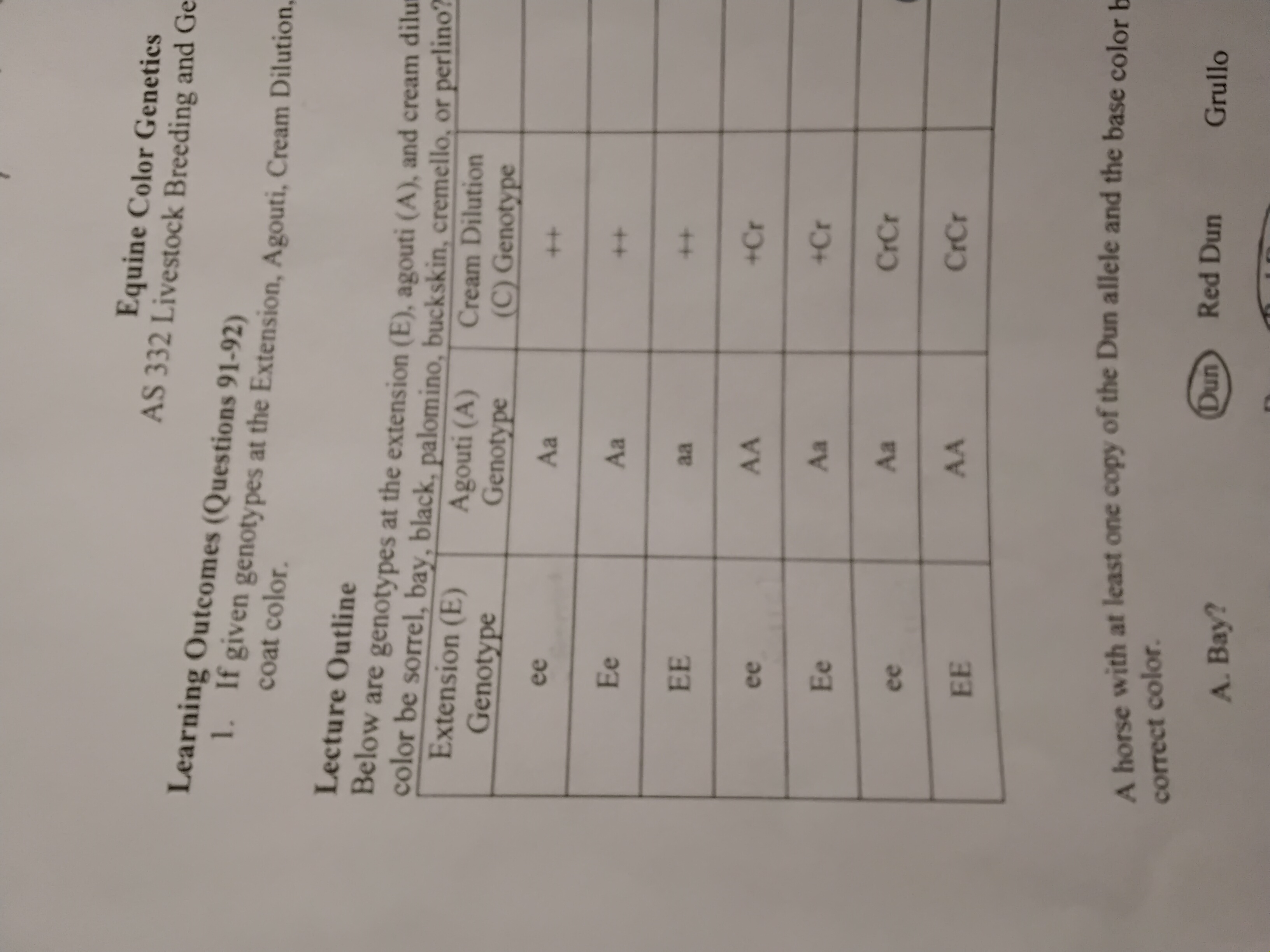
(91) Below are genotypes at the extension (E), agouti (A), ad cream dilution (C) loci. Will the horse’s coat color be sorrel, bay, black, palomino, buckskin, cremello, or perlino
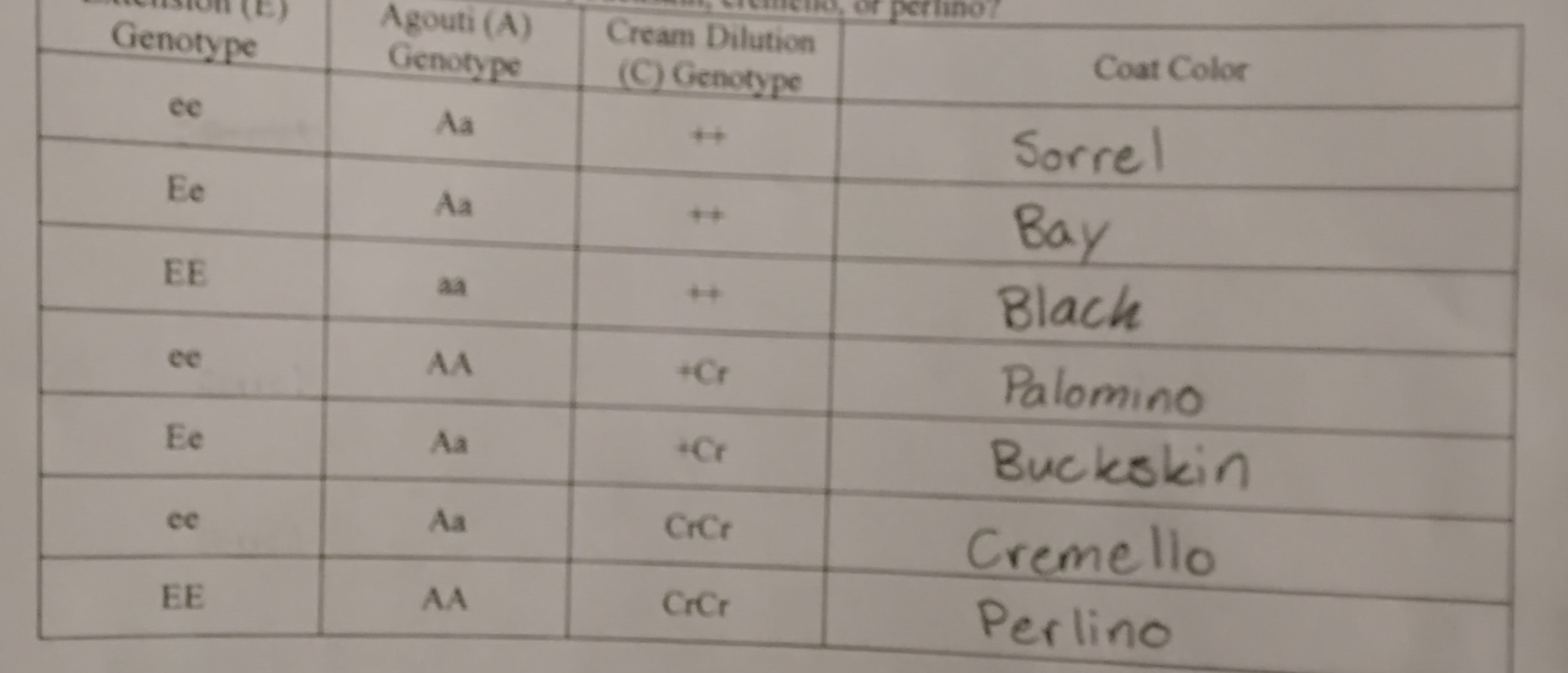
(92) A horse with at least one copy of the Dun allele and the base color below will be what color?
A. Bay?
B. Sorrel?
C. Black?
A. Dun
B. Red dun
C. Grullo